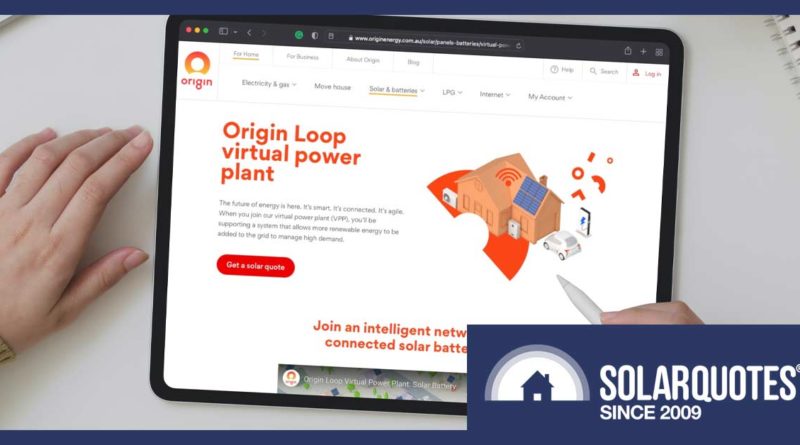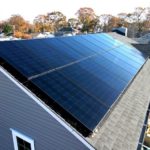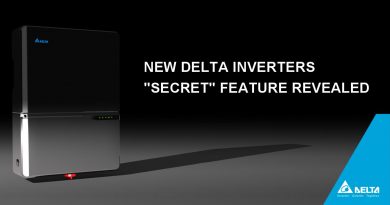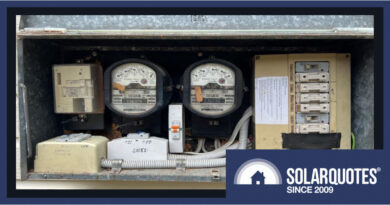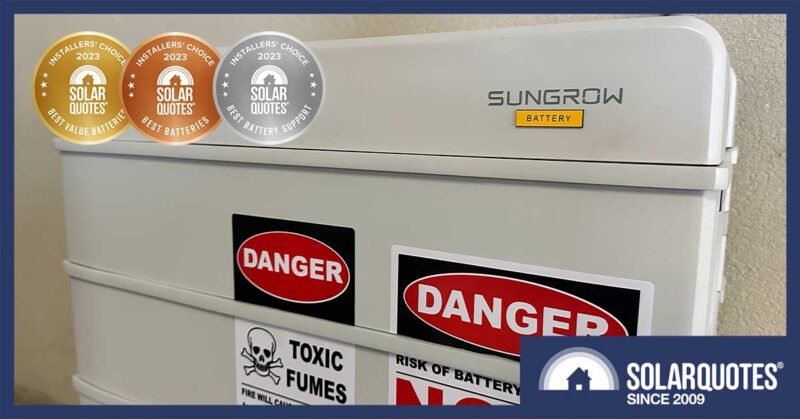Origin Loop Virtual Power Plant: $2,000 Bait On A 5-Year Hook
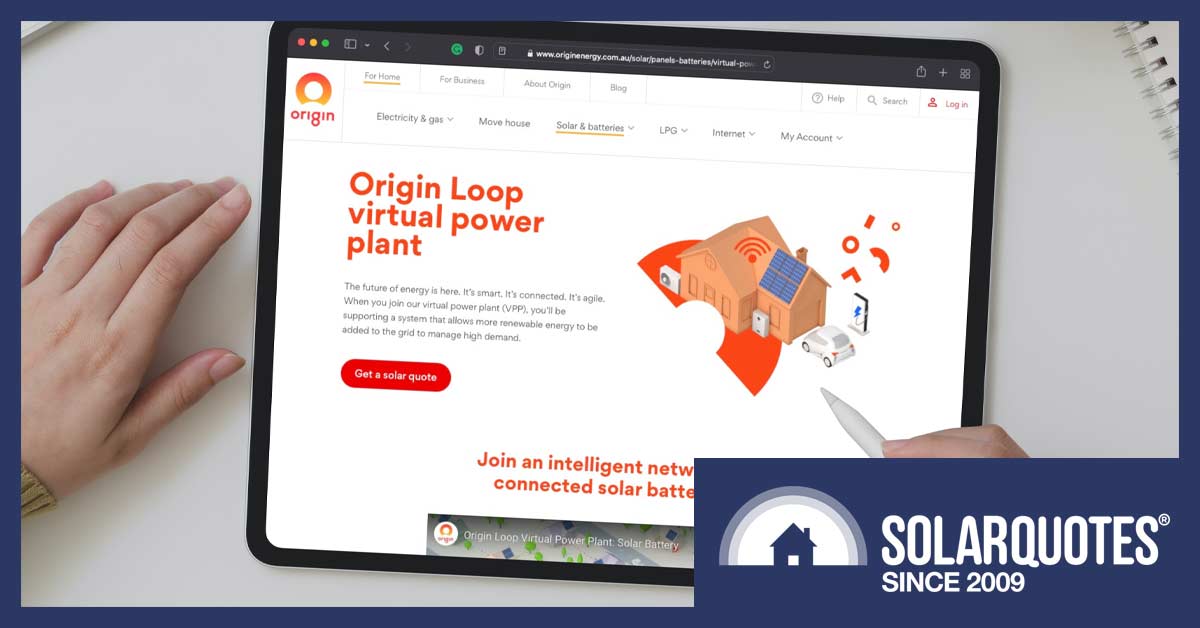

Origin Energy’s ‘Origin Loop’ Virtual Power Plant (Loop VPP) pays you to let Origin discharge your battery into the grid, but you must have an Origin retail electricity plan to use it.
Even though there’s a big dollar incentive up front, I don’t think it’s a good deal overall. In this post, I’ll tell you why I’m not excited about the deal, and hopefully, that will help you decide for yourself whether to sign up.
At the moment, there are two ways to join the Origin Loop VPP, and they result in very different outcomes, so try not to confuse them:
- Loop VPP BYO: If you currently have a Tesla Powerwall 2, you can join and be paid $1 for every kilowatt-hour they discharge from your battery and send into the grid. You will have to pay for the energy they discharge. You’ll receive a $400 credit on electricity bills when you sign up. You are not locked in and can leave after 20 days. At the moment, there’s no time limit on this deal. It’s available in NSW, VIC, QLD and the ACT.
- Buy a battery from Origin: If you join the Loop VPP by buying a battery from Origin, they will pay you $240 a year in return for discharging up to 200 kilowatt-hours from your battery. You’ll need to pay for the energy discharged and be locked into a contract for years. Origin says they will provide $2,000 off the cost of the battery they install if you join before September 30th 2022. This deal is only available if your home is within 50km of the centre of Sydney, Melbourne, Brisbane, or Surfers Paradise.
In this article, I will:
- Briefly describe how the Origin Energy Loop Virtual Power Plant works.
- Give details on the two different ways to join.
- Explain why it may be poor judgement to bite the hook dangling from the Loop, despite the flashy bait Origin has put on it.
What’s A Loop VPP?
A Virtual Power Plant (VPP) allows a central authority to control multiple batteries in homes and businesses. It can charge them up when wholesale electricity prices are low and discharge them when they’re high. It virtually functions as one large power plant, hence the name.
For more details on the Loop Virtual Power Plant, you can watch a 65-second video Origin Energy made. I paid close attention but, because people in the office were doing real work, I had to listen to it with the sound off. But I’m sure I got a pretty good grasp of what was going on, as the visual summary I’ve made will show:


Because there is a slight chance I may have misinterpreted it, you can watch it for yourself with sound:
[embedded content]
For people who’d rather not waste 65 seconds of their life on an ad, you can read Origin Energy’s four-point, explanatory diagram of how the Loop VPP works if you buy a battery system from them:
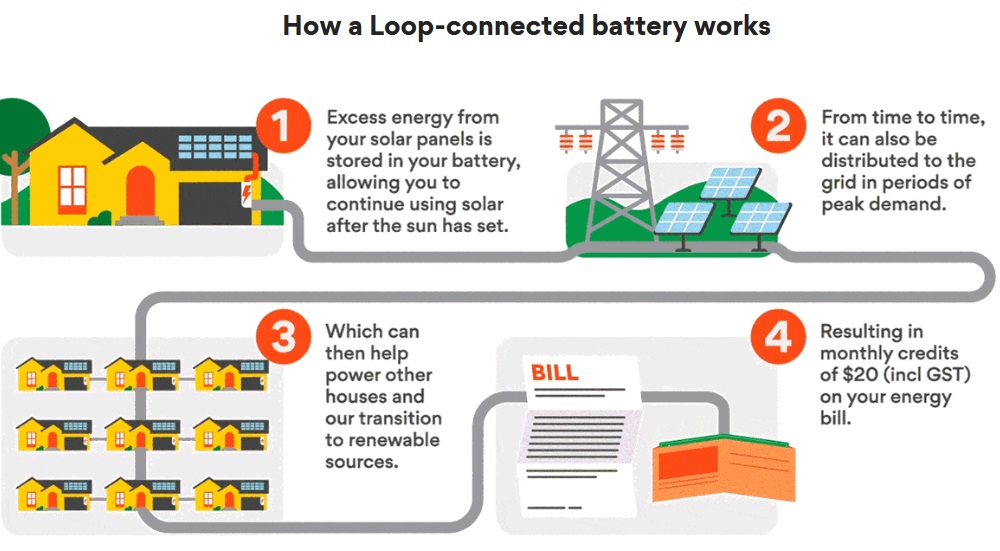

The diagram makes it appear only clean solar energy will be sent into the grid. In reality, Origin will charge your battery from the grid when they think it will benefit them. They also leave out the fact you’ll have to pay for the energy they send into the grid, either through foregone solar feed-in tariff or because you’ll have to pay the normal grid price when Origin charges it up.
There’s also a fifth part to the diagram:
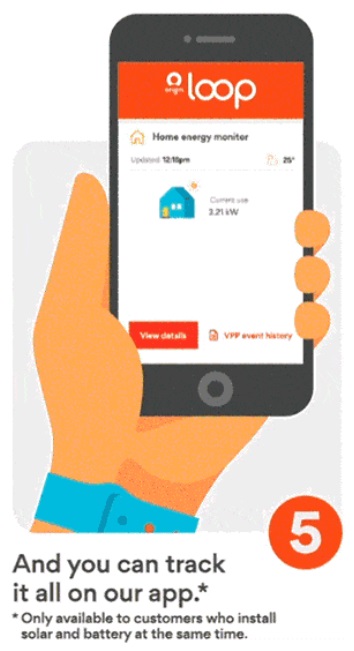

If you buy solar panels and a battery from them, you can track the Origin Energy Loop VPP on a phone app. But this isn’t much of a sales point these days, as toothbrushes come with apps. It would be surprising if it didn’t have one.
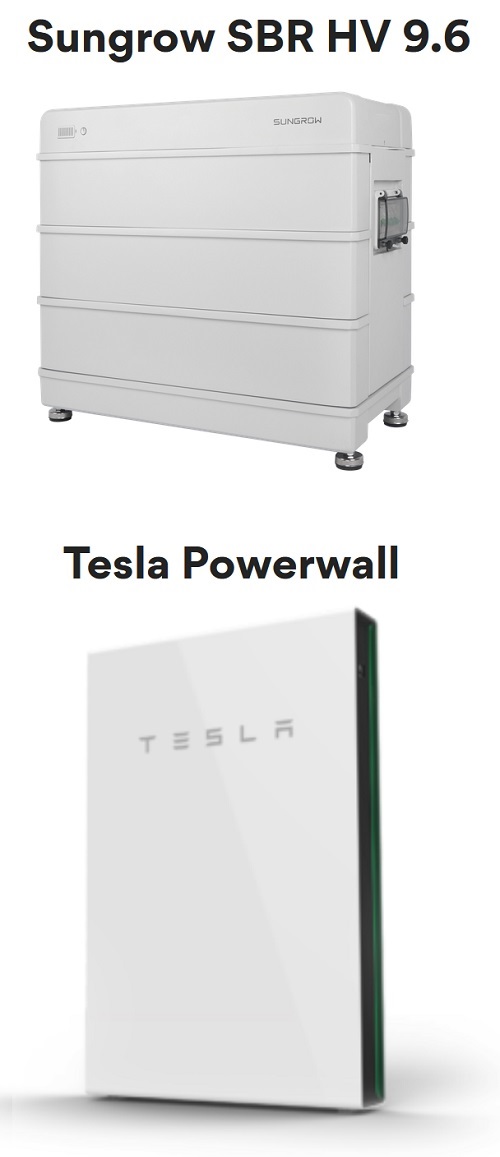
If you join the Loop VPP by buying a battery from Origin, your choice will be limited to these two batteries.
Loop Virtual Power Plant BYO
If you already have a Tesla Powerwall 2, you can join the Origin Loop VPP BYO provided you meet the following conditions…
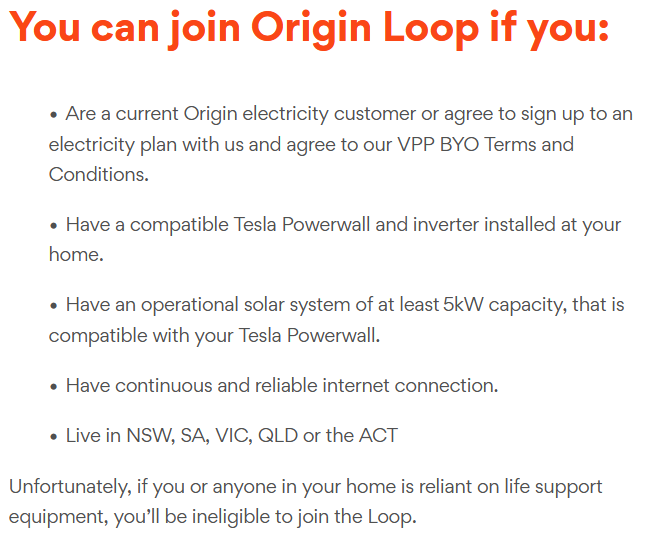

Note this offer is available in a far wider territory than joining the Loop VPP by buying a battery from Origin.
The Loop BYO VPP works as follows:
- You must have or get an Origin retail electricity plan.
- Origin will discharge up to 500 kilowatt-hours from your battery per year and can charge it as they desire.
- You will be paid $1 for each kilowatt-hour they discharge.
- When they discharge the battery, it will cost you money. (They don’t mention this upfront, but it’s buried in the terms and conditions.)
- They can prevent you from using energy stored in the battery so they can discharge it for their benefit later.
- When they discharge the battery, they always leave at least 20% of a full charge. That’s 2.7 kilowatt-hours for a new Powerwall 2.
- Origin will give you $400 in electricity bill credit when you sign up.
- You are not locked in and can leave by giving 20 days’ written notice. (The terms and conditions specifically say 20 days, not 20 work days.)
It’s interesting they give $400 credit on your first electricity bill after signing up because there is no long-term lock-in. You could get the $400 credit and then leave the VPP in under a month. But my guess is the average person who owns a home battery has considerable disposable income and isn’t going to go scrounging electricity credit money like that. I know I wouldn’t. Why would I when I make more than that every year?
[embedded content]
Buy A Battery From Origin & Go Loopy
The second way to join the Loop VPP is to buy a battery — or solar and a battery — from Origin while meeting the following requirements:
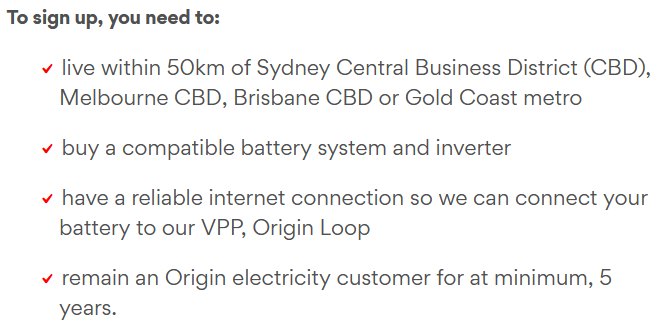

I consider two of these conditions to be quite painful. They are:
- Buying a solar power and battery system from Origin, and…
- Remaining an Origin customer for 5 years.
I’ll explain why below, but first, I’ll summarize the main points of the deal when you join the Loop VPP by buying a battery from Origin:
- You buy a home battery, or solar and a battery, from Origin and join their Loop Virtual Power Plant.
- You must use an Origin retail plan.
- Origin will pay you $20 a month in electricity bill credit. This totals $240 a year.
- They will discharge up to 200 kilowatt-hours per year from your battery.
- You will pay for the electricity they discharge.
- They can prevent you from using energy stored in the battery so they can discharge it for their benefit later.
- When they discharge the battery, they are not required to leave any energy for your own use.
- You will be locked into a 5-year contract. If you breach it you’ll be charged an early termination fee that will be outlined in your contract. After the five years is up, the contract continues until either side decides to end it.
- As an enticement, you will receive $2,000 off the price of your Origin battery, or solar and battery, system.
- This offer ends on the 30th of September 2022.
There are seven reasons why I don’t think this plan is good for the large majority of households — or maybe even all of them. Many other VPPs have similar problems, but just because something bad is common doesn’t make it good. The seven reasons are:
- I don’t recommend buying a battery or solar from Origin.
- Origin is currently offering low solar feed-in tariffs, so I don’t recommend their retail electricity plans for solar households.
- You must pay for the electricity Origin discharges from your battery, so the payments for letting them use your battery are less than they seem.
- They can stop you from discharging the battery to provide electricity for your own use.
- Their use of your battery will increase the rate it degrades.
- It increases the chance you won’t have backup power during a blackout.
- Time pressure is applied as a sales tactic, but it often pays to wait.
1. I Don’t Recommend Buying Batteries Or Solar From Origin
I don’t have any good information on the quality of Origin battery installations, but I do know what people think of the quality of their solar system installations. If you go to the SolarQuotes Origin Energy solar reviews page and click on, “See Australia-Wide Ranking,” it will show you this graph:
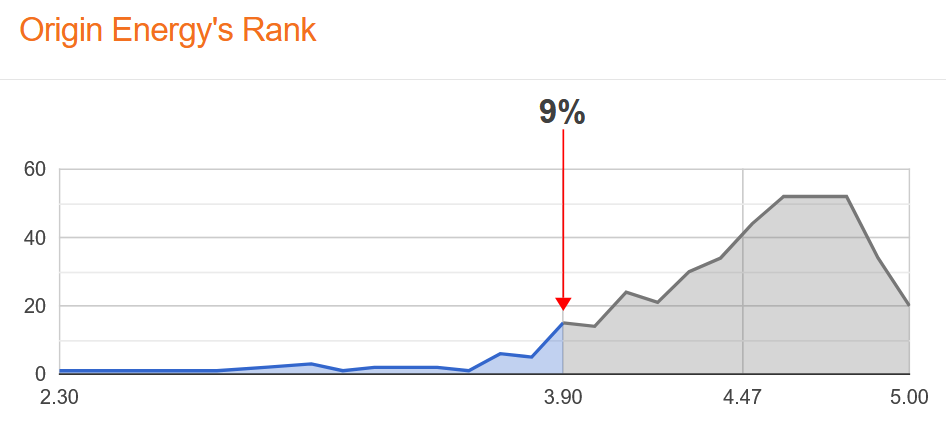

This shows that for solar installers that have received 25 reviews or more, only 9% have a customer review ranking equal to or less than Origin’s. I don’t recommend using a company that ranks this poorly. When you use Origin, it appears to be a matter of luck if you get a good or a poor installation.
It’s possible their battery installations will be better than this suggests, but I wouldn’t count on it. One positive possibility is they’ll fix problems that occur with your battery faster if you are part of their VPP, so they can use it for their benefit.
2. Origin’s Feed-in Tariffs Are Low
Because Origin’s solar feed-in tariffs are low, if you are locked in to using them for five years, you can potentially lose out on a considerable amount of money. A Sydney home with a battery and the following annual figures…
- 6,000 kilowatt-hours total electricity consumption1
- 1,500 kilowatt-hours of grid electricity consumption
- 9,000 kilowatt-hours of solar generation from a 6.6 kilowatt solar system
- 4,500 kilowatt-hours of solar exports
Could use Origin’s Solar Boost retail electricity plan, which has:
- Grid electricity charges of approximately 30.5 cents per kilowatt-hour
- A daily supply charge of 88.5 cents
- A solar feed-in tariff of approximately 8 cents per kilowatt-hour for this household
Alternatively, they could use Powershop’s Supersolar plan, which currently advertises:
- Grid electricity charges of approximately 29 cents per kilowatt-hour
- A daily supply charge of 65 cents
- A solar feed-in tariff of 13 cents per kilowatt-hour
With Origin, their electricity bill over a year would come to: $421
With Powershop, it would come to: $87
That’s a saving of $334. If it remained constant for 5 years, the difference would total $1,670. That’s not too far off the $2,000 bait Origin offers.
Note there may be an electricity plan out there that’s even better for this household than Powershop’s. I just used it as an example because of its high solar feed-in tariff2.
These calculations didn’t include VPP payments, but if the household uses Powershop they may be able to join another VPP that provides payments similar to, or possibly greater than, Origin Loop.
Important No Battery Note: If the household above didn’t have a battery, their annual electricity bill on the Origin plan would be approximately $983 while on the Powershop plan it would be $487. This is very approximate, as it will depend on electricity consumption patterns. This means they could save around $400 over a year by having a battery. At this rate it would take a $14,000 battery 35 years to pay for itself and most home battery warranties end at 10 years or earlier.

Origin Loop VPP — It’s crunchy, just like a chocolate South American Tropical Bird!
3. The VPP Payments Are Not As High As They Seem
If you bring your own Powerwall 2 to the Loop VPP BYO then Origin will pay you $1 for every kilowatt-hour they drain from your battery, up to a maximum of $500 for 500 kilowatt-hours. If you join by buying a battery from them they’ll pay you $240 a year for discharging up to 200 kilowatt-hours. That’s not a lot of money compared to what Origin will receive for it, given the wholesale price of electricity can reach $15.50 per kilowatt-hour.
But what you will receive is less than it seems because you will have to pay for the energy they send into the grid in one, or a combination, or two ways:
- By not receiving a feed-in tariff for solar energy that otherwise would have been sent into the grid by your solar system, and/or…
- By paying for grid electricity Origin will use to charge the battery.
On top of this, because batteries aren’t 100% efficient, you’ll have to pay for more electricity than Origin discharges. A Powerwall 2 has a round trip efficiency of around 88%. This means to discharge one kilowatt-hour it has to be charged with 1.14 kilowatt-hours. Assuming your solar feed-in tariff is 8 cents and grid electricity is 30.5 cents, for each kilowatt-hour discharged you’d have to pay:
- 8 cent solar feed-in tariff = 9.1 cents of electricity per kilowatt-hour discharged
- 30.5 cent grid electricity price = 34.7 cents per kilowatt-hour discharged.
In this situation, if half the energy Origin discharges comes from solar power and the other half from the grid, the household would have to pay $44 dollars for every 200 kilowatt-hours the Origin Loop VPP exports to the grid. This would make a $240 annual payment under $200 net.
Not charging households for energy used to charge the battery was an option, but Origin decided not to take it.
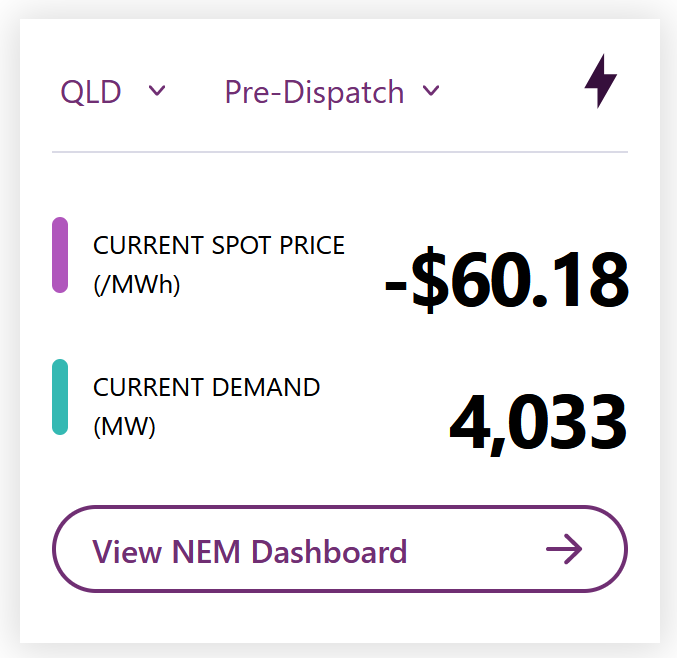
As this example from QLD at 1:15 pm on Saturday shows, its possible for electricity prices to be negative. VPPs will be paid money to charge batteries at these times. Despite this, households will still have to pay the normal price if the Loop VPP charges the battery at this time.
4. Loop VPP Can Stop You Using Energy In Your Battery
Another potential cost from joining the Origin Energy Loop VPP is you can be prevented from using energy stored in your battery if Origin thinks they may want to discharge it later. This can cost you money by causing your home to consume grid electricity instead of stored solar energy.
Also, there is nothing in the terms and conditions that prevent Origin from charging the battery with far more grid energy — that you pay for — than it supplies to the grid. All they do is promise you will not pay more for electricity than you receive in payment. While I hope they wouldn’t abuse their power in this way, if they did, your “payment” could turn into a pittance. Origin could simply promise not to charge the battery with more grid energy than they discharge from it. The fact they don’t is a concern.
5. Joining A VPP Is Degrading
While the Loop VPP BYO promises to discharge no more than 500 kilowatt-hours a year for those who bring their own Powerwall, and there’s a maximum of 200 kilowatt-hours a year for those who join by buying a battery from Origin, this still represents extra wear and tear on your battery and will cause it to degrade faster than it otherwise would. It can cause the battery to die sooner than you’d prefer, which is a cost that should be considered.
In addition to wear and tear from Origin Energy discharging your battery, there’s no set limit on how often Origin can charge your battery, so the wear and tear could be considerably worse than the discharge limits suggest.
Before you buy a battery, you can estimate the cost of storing each kilowatt-hour of electricity. Divide the total stored energy provided over the battery’s lifetime by the cost of the battery.
But after you’ve bought a battery, the calculation changes. The battery becomes a sunk cost, and you’ll have to decide what the marginal cost of letting Origin discharge your battery will be. Pinning down a figure is difficult as it depends on a number of factors, including the type of battery and personal preferences, but most people should probably regard wear and tear as costing them around 10 cents or more per kilowatt-hour.
6. You May Have No Backup Power
The Loop VPP BYO promises to leave at least 20% of a full charge in your battery when Origin discharges it. Despite leaving some energy, this still increases the chance the battery will either be flat or only have a meagre amount of energy when a blackout occurs. As Origin is extremely likely to discharge your battery on days when rolling blackouts occur, your odds of being caught short in a blackout may be higher than you expect.
If you join the Loop Virtual Power Plant by buying a battery from Origin, they do not promise to leave any energy in that battery when they discharge it. While they promise to discharge no more than 200 kilowatt-hours per year, this will still increase your odds of sitting in the dark during a blackout.
7. Time Pressure Sales Tactics Are Frequently Phoney
If you act now and join the Loop VPP by buying a battery system from Origin, you’ll get a discount of $2,000 — but only before September 30th!
I don’t recommend giving in to this kind of time-pressure sales tactic. While it is possible to miss out on a good deal by delaying, you’re probably not missing out on much. No one at this time should be in a big hurry to buy a home battery. They’re currently unlikely to save you money, so there’s no real chance you’ll end up poorer than you otherwise would be by spending time finding out what other offers are available or by waiting to see if anything better comes along.
The simple fact is, Origin would not be offering $2,000 off a battery installation if they did not think they would come out ahead on the sale. After September 30th, it won’t suddenly cost them $2,000 more to install a battery. So chances are, before long, they’ll come up with some other way to convince people to buy batteries that may be as good or better. The same goes for others trying to convince you to buy their batteries.
My advice is to take your time, educate yourself, and decide if a home battery is what you really want. If you decided you want one now, my advice is to go with an installer who has an excellent reputation for customer service because home batteries often have issues that may appear immediately or may only become apparent years after installation.
Footnotes
Original Source: https://www.solarquotes.com.au/blog/origin-loop-vpp-review/

